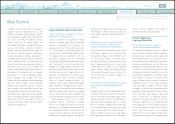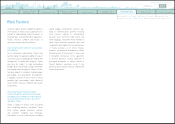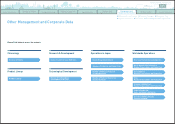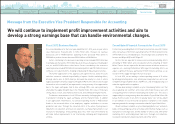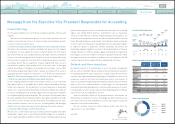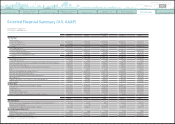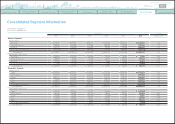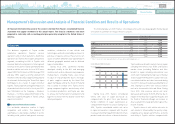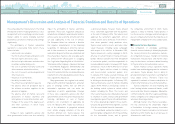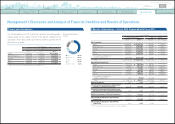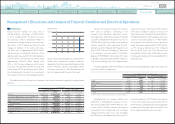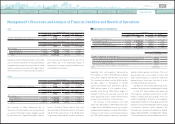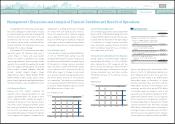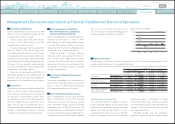Toyota 2012 Annual Report Download - page 49
Download and view the complete annual report
Please find page 49 of the 2012 Toyota annual report below. You can navigate through the pages in the report by either clicking on the pages listed below, or by using the keyword search tool below to find specific information within the annual report.
TOYOTA ANNUAL REPORT 2012
Toyota Global Vision Changes for Making
Ever-Better Cars President
ʼ
s Message Medium- to Long-Term
Growth Initiatives Special Feature Management and
Corporate Information Investor Information
Business and
Performance Review Financial Section
Management's Discussion and Analysis of Financial Condition and Results of Operations
All financial information discussed in this section is derived from Toyota
s consolidated financial
statements that appear elsewhere in this annual report. The financial statements have been
prepared in conformity with accounting principles generally accepted in the United States of
America.
The business segments of Toyota include
automotive operations, financial services
operations and all other operations. Automotive
operations are Toyota
ʼ
s most significant business
segment, accounting for 89% of Toyota
ʼ
s total
revenues before the elimination of intersegment
revenues for fiscal 2012. Toyota
ʼ
s primary markets
based on vehicle unit sales for fiscal 2012 were:
Japan
(
28%
)
, North America
(
25%
)
, Europe
(
11%
)
and Asia
(
18%
)
. Japan
ʼ
s economy suffered from
the effects of the Great East Japan Earthquake and
its aftermath
(
collectively, the
“
Great East Japan
Earthquake
”)
. As a result, in Japan and other
regions, Toyota experienced negative impacts on
its production in the first half of fiscal year 2012.
See
“
Information on the Company
—
Business
Overview
—”
for more detailed information of the
Great East Japan Earthquake in Toyota
ʼ
s annual
report on Form 20-F.
The worldwide automotive market is highly
competitive and volatile. The demand for
automobiles is affected by a number of factors
including social, political and general economic
conditions; introduction of new vehicles and
technologies; and costs incurred by customers to
purchase or operate vehicles. These factors can
cause consumer demand to vary substantially in
different geographic markets and for different
types of automobiles.
During fiscal 2012, automotive markets
developed steadily in the U.S. and emerging
countries such as Asia. However, many Japanese
manufacturers, including Toyota, were forced
to adjust or stop productions due to shortages
of parts supplies caused by the Great East
Japan Earthquake and by the flood in Thailand
that occurred in October 2011. Toyota and its
group companies together exerted every effort
to normalize production, and Toyota was able
to achieve full normalization of production and
begin its recovery from the disaster sooner than
initially anticipated.
The following table sets forth Toyota
ʼ
s consolidated vehicle unit sales by geographic market based
on location of customers for the past three fiscal years.
During fiscal 2011, Toyota
ʼ
s consolidated
vehicle unit sales in Japan decreased as
compared with the prior fiscal year because
market conditions in Japan deteriorated as
compared with the prior fiscal year. During fiscal
2012, Toyota
ʼ
s consolidated vehicle unit sales
in Japan increased as compared with the prior
fiscal year reflecting frequent introduction of new
products and sales efforts of domestic dealers.
Toyota and Lexus brands
ʼ
market share in Japan
excluding mini-vehicles was 45.5%, and Toyota
ʼ
s
market share
(
including Daihatsu and Hino
brands
)
in Japan including mini-vehicles was
43.2%, both maintaining the high level of market
share in Japan from the prior fiscal year. Overseas
consolidated vehicle unit sales increased during
fiscal 2011, whereas they decreased during fiscal
2012. During fiscal 2011, total overseas vehicle
unit sales increased in Asia and Other. During
fiscal 2012, total overseas vehicle unit sales
decreased, particularly in North America due to
impact of the Great East Japan Earthquake and
the flood in Thailand, although an increase in
Asia resulted from steady demand in spite of the
flood in Thailand.
Toyota
ʼ
s share of total vehicle unit sales in
each market is influenced by the quality, safety,
reliability, price, design, performance, economy
and utility of Toyota
ʼ
s vehicles compared with
■
Automotive Market Environment
Overview
Thousands of units
Year Ended March 31,
2010 2011 2012
Japan 2,163 1,913 2,071
North America 2,098 2,031 1,872
Europe 858 796 798
Asia 979 1,255 1,327
Other* 1,139 1,313 1,284
Overseas total 5,074 5,395 5,281
Total 7,237 7,308 7,352
*
“
Other
”
consists of Central and South America, Oceania, Africa and the Middle East, etc.
‘12‘09 ‘10‘08 ‘11
0
2,000
4,000
6,000
8,0 00
10,000
(Thousands of units)
Consolidated Vehicle Sales
0820
Search NextPrev page 49
Contents



